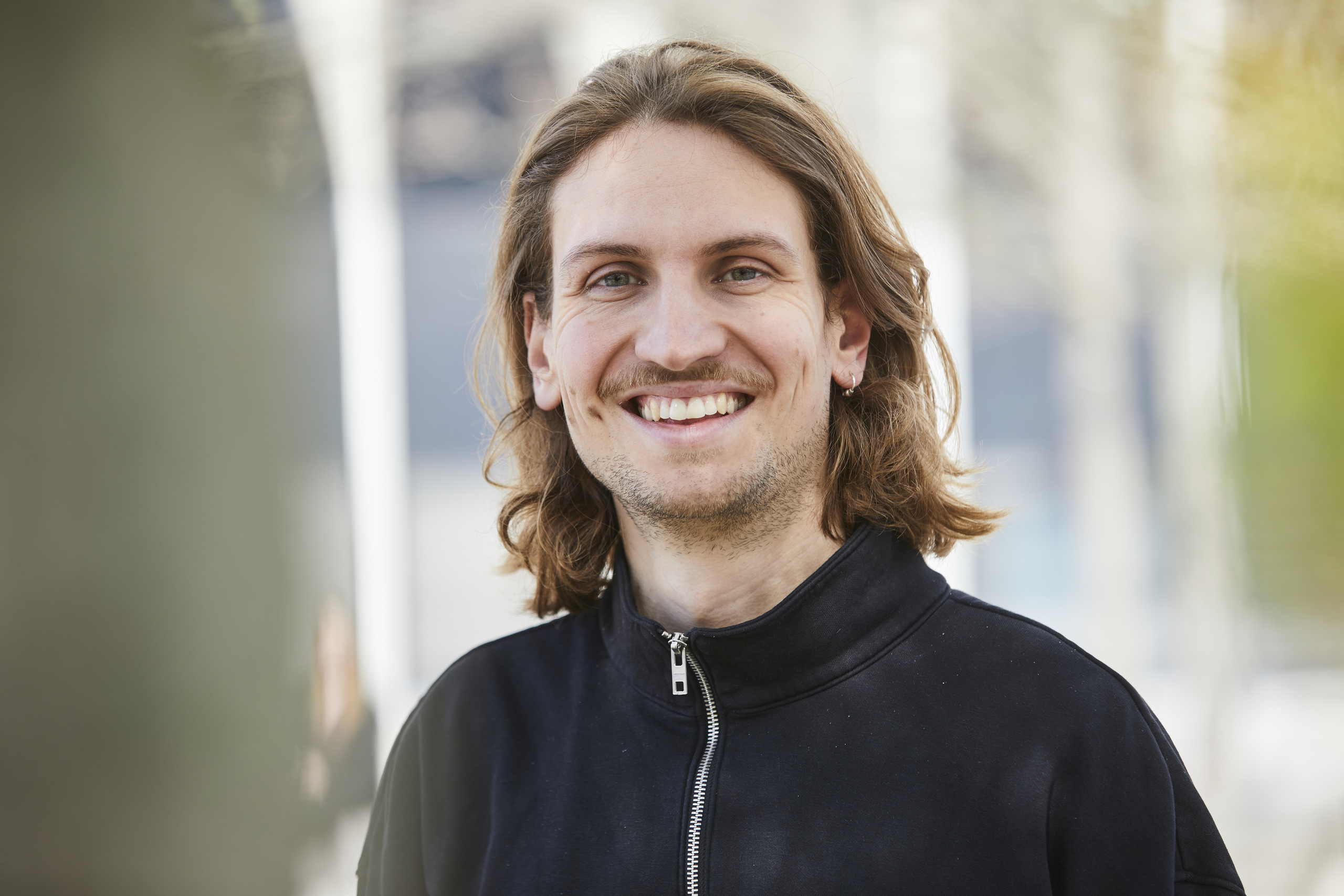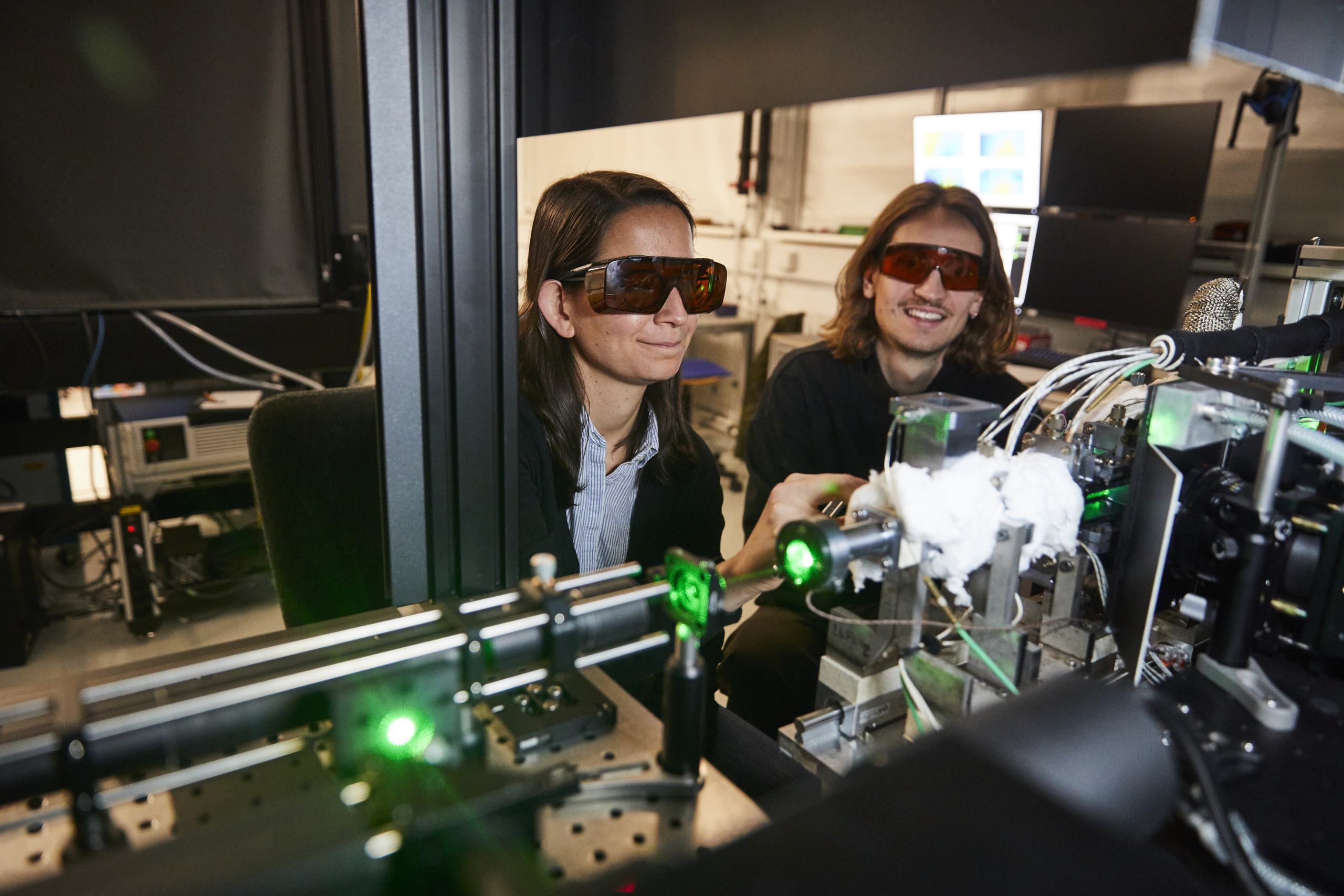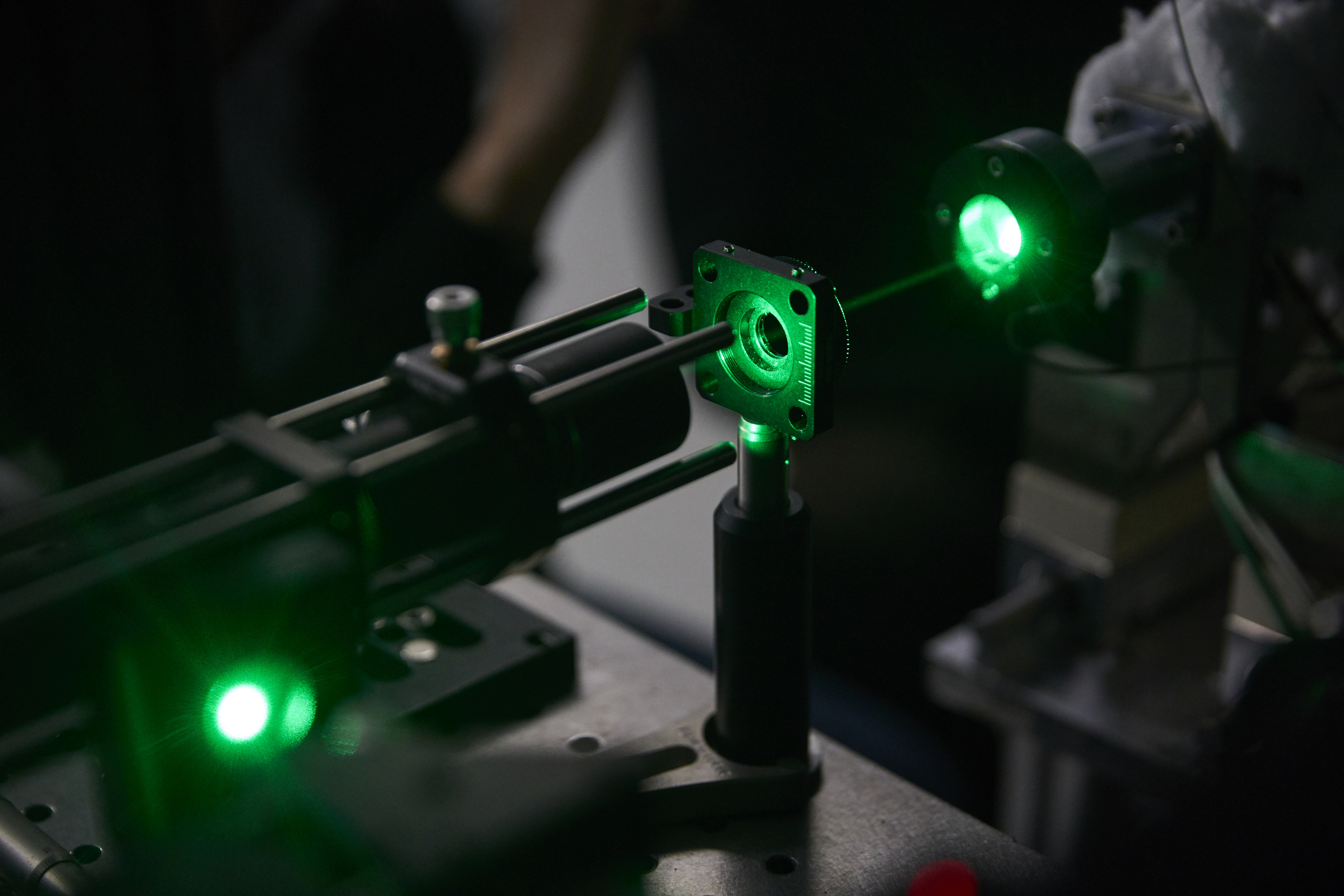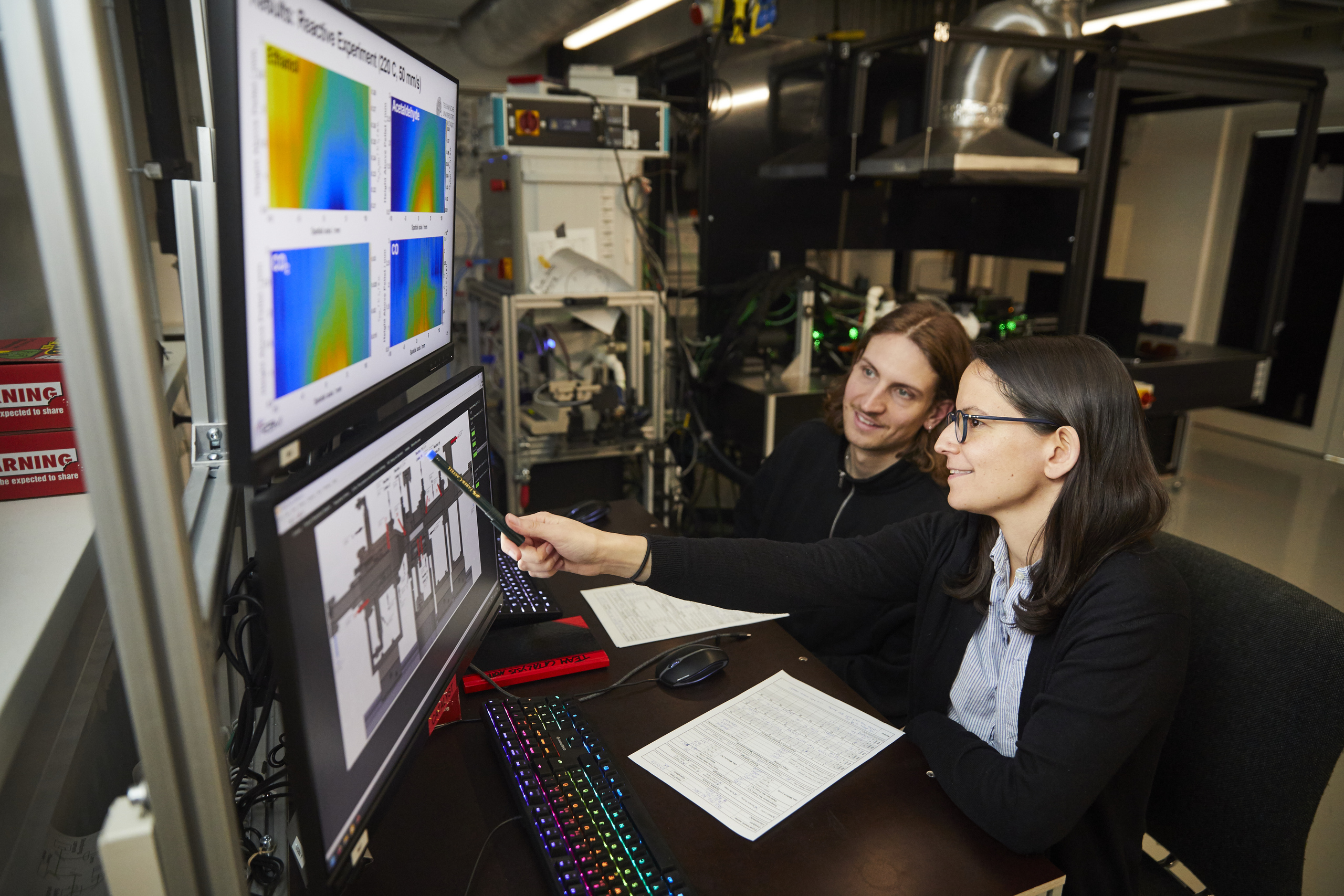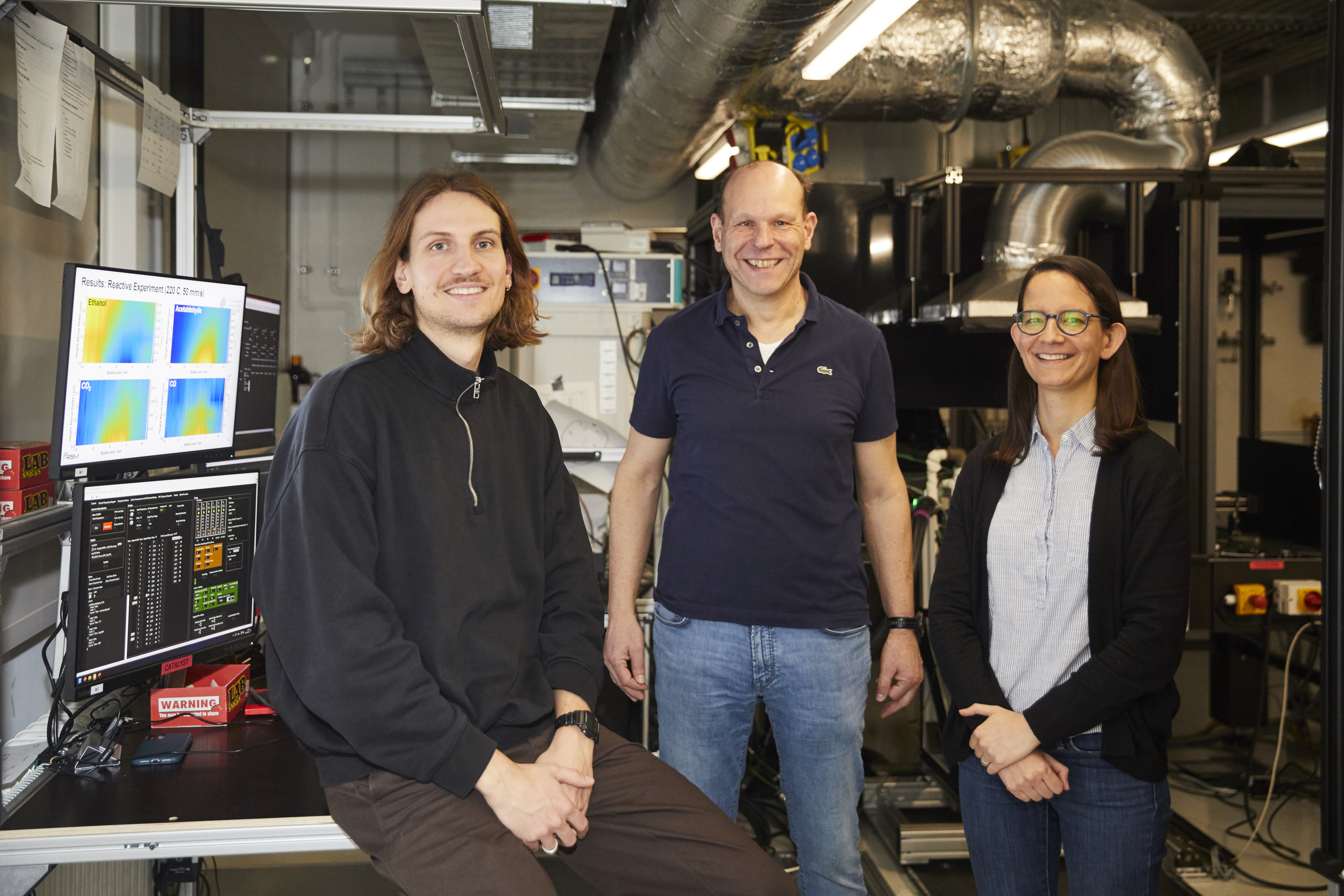ODEE-Lab

In the Laboratory for Optical Diagnostics and Renewable Energies (ODEE) at h_da led by Professor Dirk Geyer, doctoral researcher Konrad Koschnick has developed an experimental setup that is unique in this form worldwide: it combines a new chemical synthesis method with a highly complex laser measurement technique. The aim is to study how to produce the base materials required in large quantities by the chemical industry in a sustainable way. What makes the project unparalleled from a scientific perspective is the extremely sophisticated technology. That is why a top young researcher from the USA joined the ODEE team for a year: Alison Ferris, who earned her doctoral degree at Stanford University, will start as a junior professor at Princeton in July. Further collaboration with h_da has already been agreed.
By Christina Janssen, 13.5.2024
When asked what it was that made her come to Darmstadt, Alison Ferris, 34, can barely suppress a grin: it was certainly not the “lovely” November weather on her first visit, says the young scientist, who completed her doctoral degree at the elite Stanford University in California in 2020. She explains her motivation for spending a year as a postdoctoral researcher in Darmstadt as follows: “I came here to learn something new.” It was Professor Dirk Geyer from h_da and Professor Andreas Dreizler from the Technical University of Darmstadt, experts in laser measurement technology who have been working closely together for many years, who gave her the opportunity to do this. Ferris first met Dreizler at an international conference and then came to the Rhine-Main region for a short visit. She did not allow “rainy Darmstadt in November” to discourage her from returning for a whole year.
For people who care about the weather, the ODEE laboratory at h_da is not the right place anyway: the room, in the middle of which a green laser beam cuts through the darkness, is completely sealed off. No ray of light from outside is allowed to disrupt the measuring processes underway inside. Alison Ferris and doctoral student Konrad Koschnick have spent a year here bringing light into the darkness. The researchers in the ODEE laboratory apply sophisticated laser measurement techniques to study combustion processes with sustainable fuels such as hydrogen and iron, which will be used in turbines, engines and power plants in the future. Recently, they have also turned their attention to catalytic chemical reactions. The aim of this innovative field of research is to produce chemical feedstocks in a sustainable way.
High-tech setup “Made in Darmstadt”
Doctoral student Konrad Koschnick, whose joint supervisors are Professor Geyer and Professor Dreizler, spent four years tinkering with an experimental setup that is now unrivalled worldwide. Together with oxygen, gaseous ethanol flows over a metal catalyst plate in a flow channel and reacts to form acetaldehyde, a substance of which around 1.5 million metric tons are produced worldwide each year – and that figure is rising. What’s new about the ODEE setup? Pretty much everything! Instead of the ethylene based on natural gas used until now, the ODEE team utilises bioethanol, a sustainable raw material, as a base material. Instead of a costly platinum or palladium catalyst in a toxic chloride solution, Koschnick is experimenting with iron oxide powder. “That is, in fact, nothing more than a kind of rust.”
In Koschnick’s flow channel, the scientists analyse the chemical reaction in real time through a combination of a high-performance laser and a complex spectroscopic process. In this way, they want to find out how the entire process can be optimised in order to conserve resources. The chemical sector is the largest industrial energy consumer worldwide and the third largest producer of direct CO2 emissions. Progress in this area could therefore be a game changer as far as climate protection is concerned. Here, the sophisticated laser measurement technology has great advantages despite its immense complexity, as Koschnick explains: “It’s like looking through a window into very complex processes.” In the case of a combustion engine, for example, scientists would generally use conventional measurement technology to measure the emissions coming out of the exhaust pipe. What exactly happens in the engine remains a kind of “black box”. “Laser measurement technology, by contrast, allows us to take contactless measurements directly ‘in line’ in the laboratory without disrupting the process – simply with light.”
In principle, it is about the interaction of light and matter. “There are scattering processes such as Rayleigh scattering, which causes the reddening of the Sun at sunset. It’s also the reason why our sky is blue. Our measurements are based on the same principle: light, in this case our laser, interacts with gas molecules. This generates photons of a certain colour, which tells us which molecule the photon originated from.” Experts call this process “Raman scattering”. In this way, gas concentrations and temperatures in the flow channel can be measured very accurately at any time. And then mathematics comes into play: “Complex algorithms help us to evaluate our measurement data, which we then feed into numerical models. With this as a basis, we can then simulate how the process would run if we were to adjust various parameters.” The project calls for a wide range of skills, from classic mechanical and chemical engineering and photonics to statistics and numerics.
Leading worldwide
That is why Professor Dirk Geyer, Koschnick’s supervisor, considers that the current project has a unique selling point: “We developed and built the flow channel and the spectrometer ourselves. At the present time, no other research institution worldwide has this combination.” This is also thanks to the fact that Geyer and his ODEE team have specialised in the method described above: the application of Raman spectroscopy in gas mixtures at high temperatures. Only a handful of groups master this challenging technique. “And that’s exactly what brought me here,” explains Alison Ferris. “My own technical background is in a different method, laser absorption spectroscopy, where we look at how molecules absorb light. Raman spectroscopy examines the opposite, so to speak, namely how molecules scatter light. Absorption versus scattering – that is the main difference. It was important for me to learn something about Raman spectroscopy here in Darmstadt.”
Dirk Geyer started setting up “ODEE” back in 2016 with just an empty laboratory. He has now been working closely with the Technical University of Darmstadt for many years: “One pillar of our collaboration is ‘Optical Diagnostics and Renewable Energies’. There is a lot of interaction between our doctoral candidates and students, and we’re working on many projects together.” For Alison Ferris, it was the expertise and international reputation of the joint group of around 40 researchers that made Darmstadt appealing. “But without considerable financial support, from the University Executive Board at h_da, too, it would not have been possible to equip the laboratory for such a complex project,” says Dirk Geyer.
After a year with top researcher Alison Ferris on board, all those involved in the project are satisfied with the initial results: “The process works,” Konrad Koschnick is pleased to say, “and we have very high selectivity. This means that we produce a lot of the desired product and very few unwanted by-products. The process runs stably over a long period. That is very important for its later use in industry.” The one-year collaboration will lead to several papers. “This is a good result,” says Alison Ferris, summing up. “We have learned a lot about what works – and what doesn’t. Both are valuable insights.” The future Princeton professor says that she has learned a lot from Dirk Geyer and his students. “The teamwork was great, and only in that way could we make all progress we did in just a few months.”
Invitation to Princeton
Incidentally, the lab also hosted a few unwanted guests for a while: “Flies like bright light,” says Koschnick with a laugh. “And a laser is a very bright light.” A spider then even joined the flies: “It nested right on one of the €300 glass panes in the flow channel. It suddenly appeared overnight.” The spider survived, but the pane had to be replaced because they are coated with a wafer-thin nano-structure. “If you touch it, it breaks. And the spider just sat on it.”
But this is the only mishap that Koschnick and Ferris can report with some amusement after reflecting for a moment. Konrad confesses that he was a little “jittery” before Alison’s arrival – so he wrote her a kind of disclaimer in advance: “I told her that not everything is up and running yet in the project, it’s still very exploratory. I can’t promise you that you’ll have great results from it in a year’s time.” But any concerns were quickly dispelled: “Alison put her gloves on straight away, and together we tinkered about with the flow channel. She had no problem at all with getting her hands dirty and was a great help.
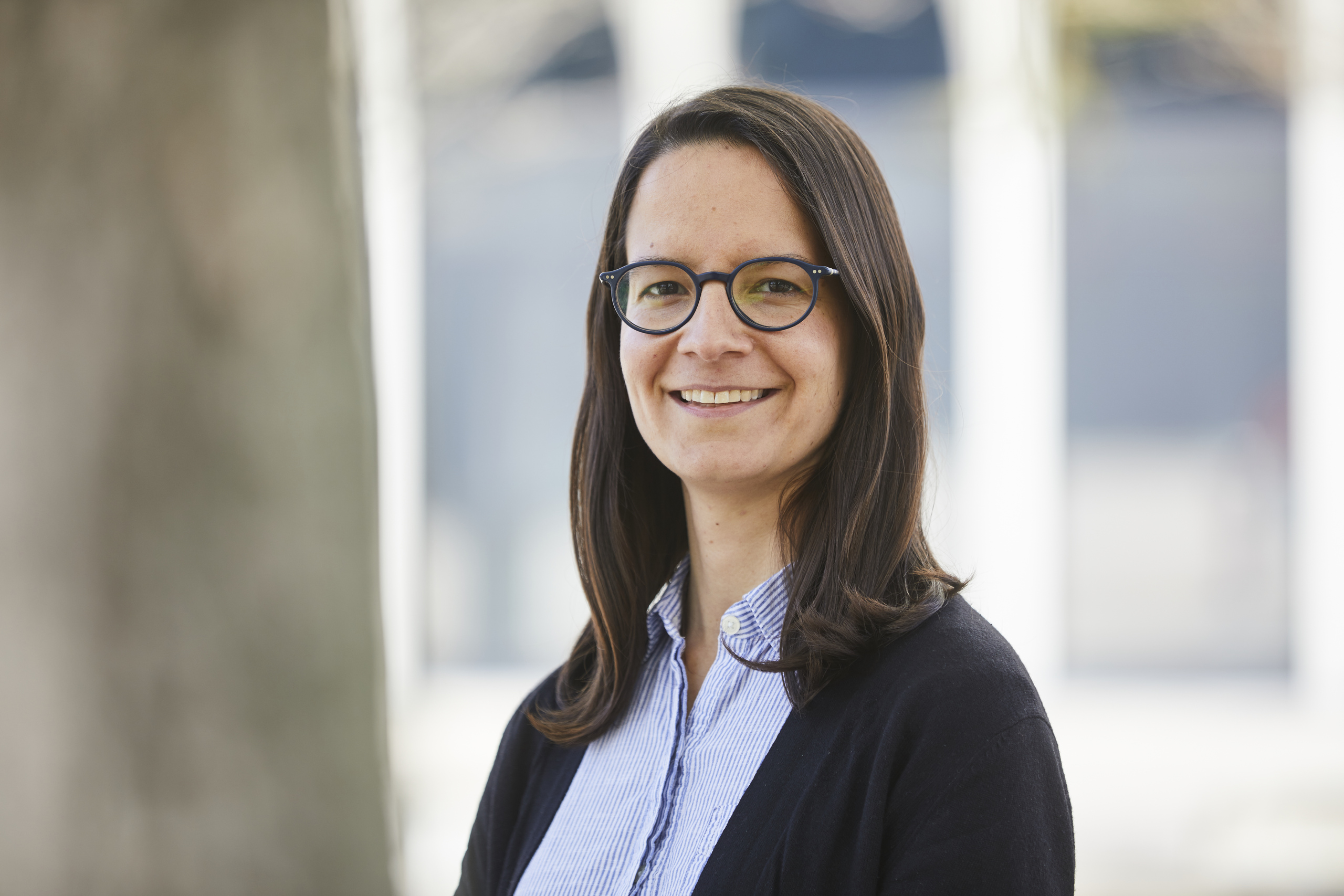
In July, Alison Ferris will begin setting up her own laboratory at Princeton University: “I’ve always been interested in fuels,” says the mechanical engineer. That is why she will initially concentrate on fuel science again when she starts work at Princeton: “My research centres on how to burn fuels, but also about how to design them in such a way that they burn more efficiently and cleanly.”
If her tight schedule allows, Alison Ferris will return to Darmstadt, as she has learned to appreciate many aspects outside the laser lab, too: “There are lots of things in Germany that are really great – the beer, the Christmas markets, the Deutschlandticket rail pass and Deutsche Bahn – German Rail – when it works...” The Darmstadt-Princeton axis is in place. And doctoral student Konrad Koschnick, 30, is likely to be one of the first to benefit from it. Although his plane ticket to the East Coast is not yet booked, one thing is already certain: as soon as he has finished his dissertation, he will spend some time in Princeton. A prospect that most people can only dream of.
Contact
Christina Janssen
Science Editor
University Communication
Tel.: +49.6151.533-60112
Email: christina.janssen@h-da.de
Translation: Sharon Oranski
Links
Professor Alison Ferris on LinkedIn and the Princeton University website
